| Home > Policy > White Paper, Notice, Announcement > White Paper > JAPANESE GOVERNMENT POLICIESIN EDUCATION, SCIENCE, SPORTSAND CULTURE1998 > MENTAL AND PHYSICAL HEALTH AND SPORTS CHAPTER3 SECTION3 3 | ||
Sports facilities are a basic requirement for the promotion of lifelong participation in sports and their development is extremely important in promoting sports.Japan's physical education and sports facilities numbered some258,000nationwide in October1996according to the"Survey on the Present Status of Facilities for Physical Education and Sports"conducted by MESSC in FY1998.More than60%of these were school physical education facilities and25%were public sports facilities.According to the"Opinion Survey on Stamina and Sports,"the most often cited request regarding public sports facilities was for"an increase in the number of facilities available nearby,"indicating that the expectations of the Japanese have not yet been met in quantitative terms.
A breakdown shows that some160,600ofthese are school education facilities(elementarythrough to university),about65,500are publicsports facilities and approximately31,900areworkplace facilities(established in governmentaloffices and companies aimed at improving employee welfare)or private sector sports facilities.In recent years,public sports facilities have beenon the rise as the sports needs of the Japanesehave increased.As for the type of facilities,gymnasiums accounted for the largest share atsome53,000,followed by multipurpose sportsgrounds at about51,000and outdoor swimming pools and tennis courts( see Table3-6 ).
As for facility size,a large proportion of track and field grounds,baseball and softball fields,ball game fields and kendo halls are largescale facilities,while a large proportion of multipurpose athletic spaces,gymnasiums and judo halls are medium-sized.Universities,colleges of technology and public sports facilities have a large number of comparatively large facilities.
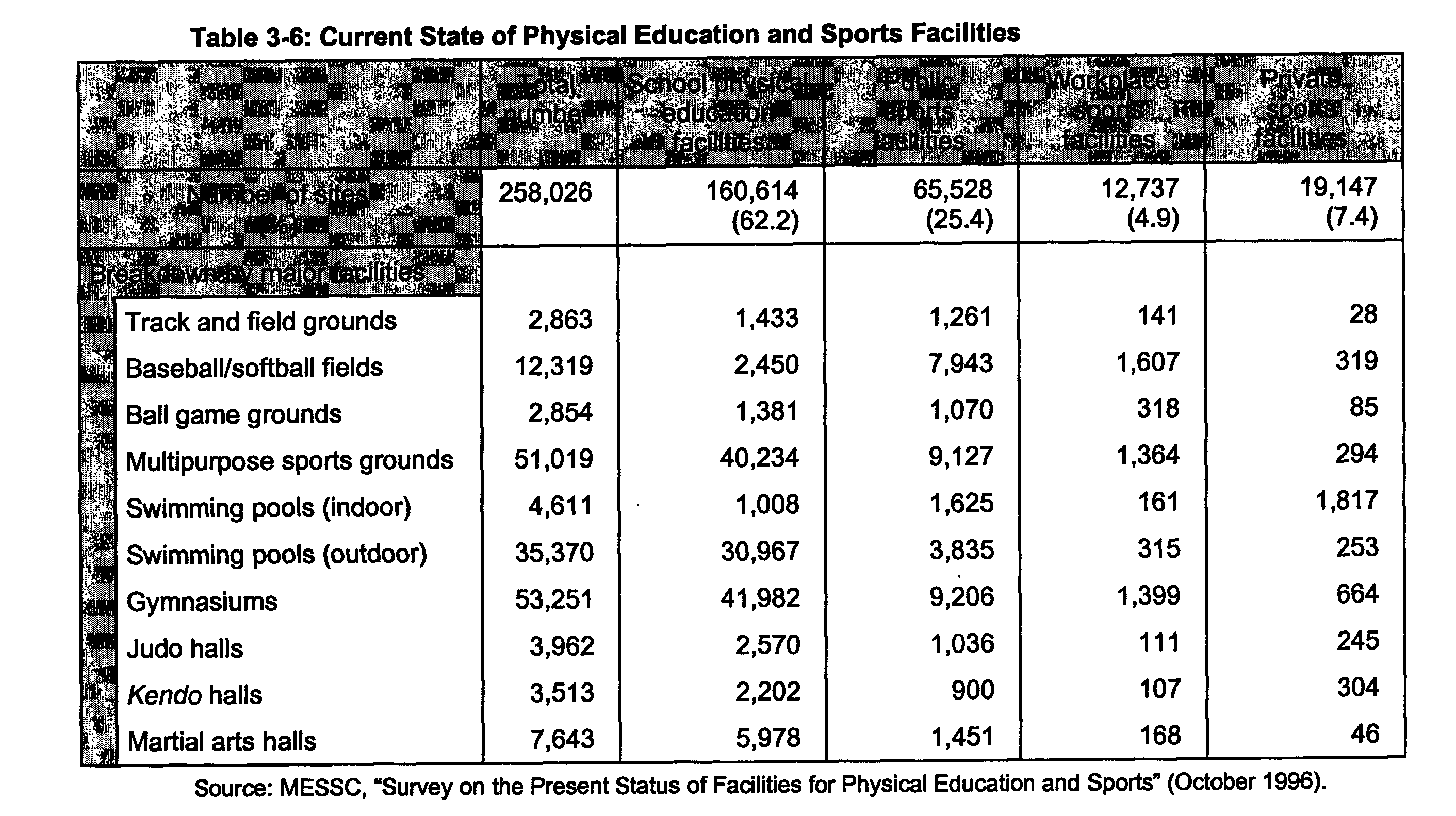
Looking at the use of sports facilities accordingto the"Survey on Health and Sports,"while children mainly use school facilities,among adultsthe rate of private and public facility use is high,with the rite of private facility use higher thanthat of public facility use in large cities.As forthe means of getting to the facilities,childrenusing their school facilities walked or rode theirbicycles,while the overwhelming majority ofadults using private and public facilities went bycar( see Figures3-20 , 3-21 ).The larger the sizeof the population,the smaller the number of people using cars and the more that walked or wentby bicycle.
According to the"Opinion Survey on Staminaand Sports,"the second most cited request regarding public sports facilities was related to amanagement matter,such as the later opening offacilities.In Japan,where people are said to worklonger hours than in Europe and America,in order to improve the rate of sports activity,there isa need to open facilities early in the morning orlate at night so that people can use them before orafter work.Even if facilities are available,it isalso essential to have appropriate sports programming and instruction so that people can enjoy sports.It is therefore necessary to place instructors in these facilities and to create anenvironment where users can engage in more fulfilling sports activities( see Figure3-22 ).
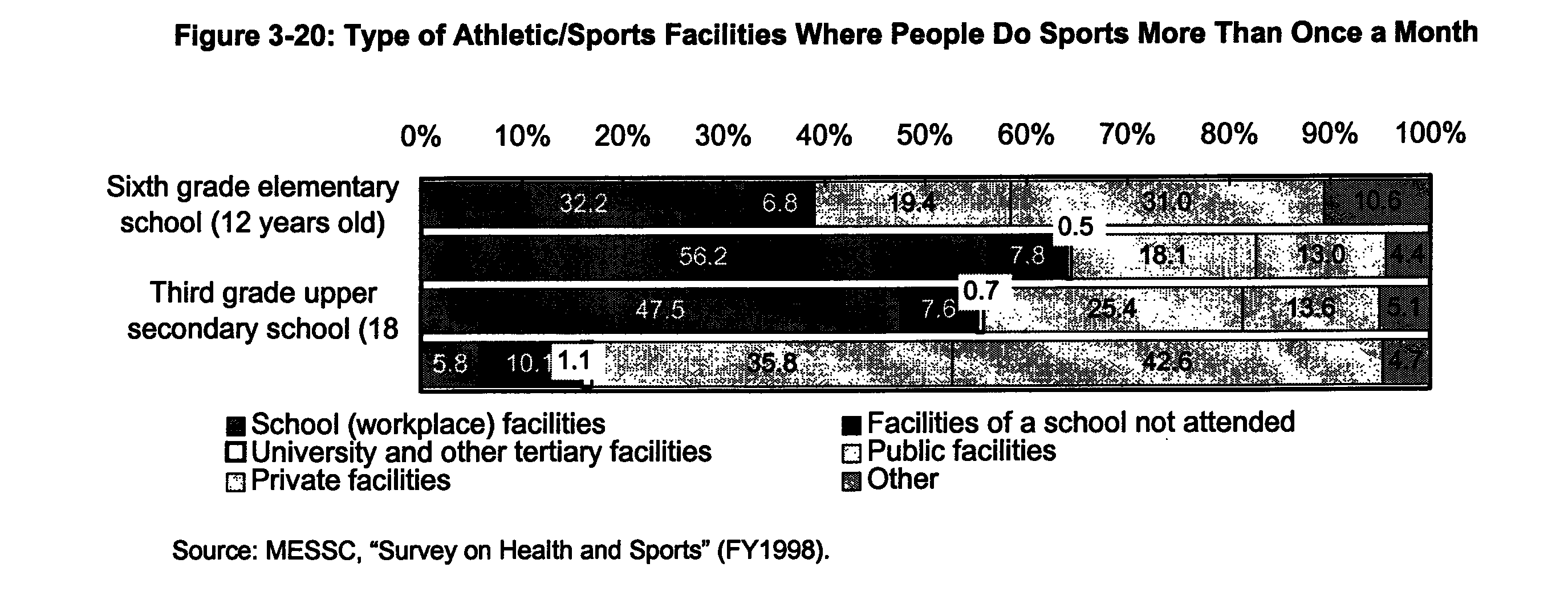
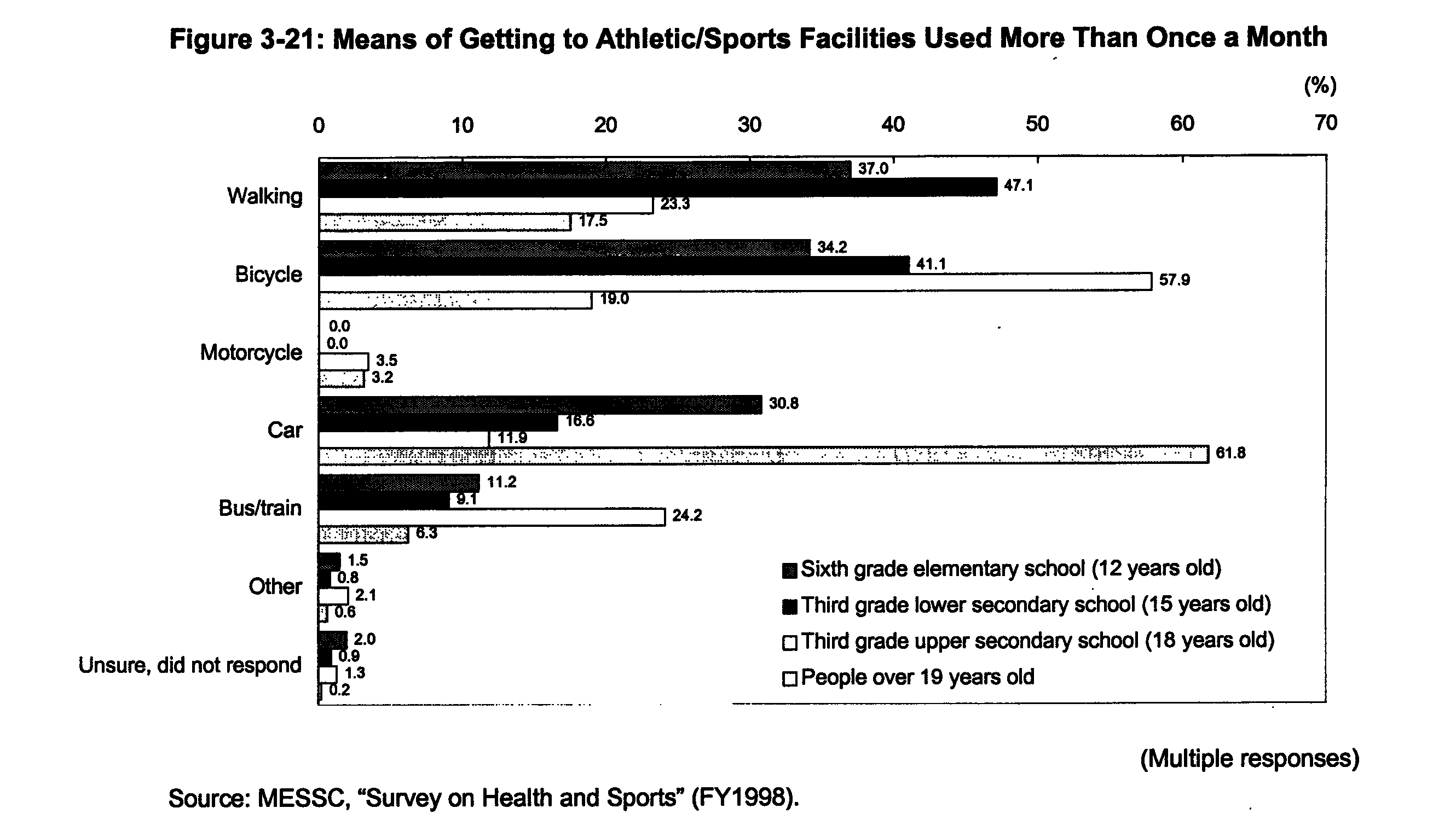
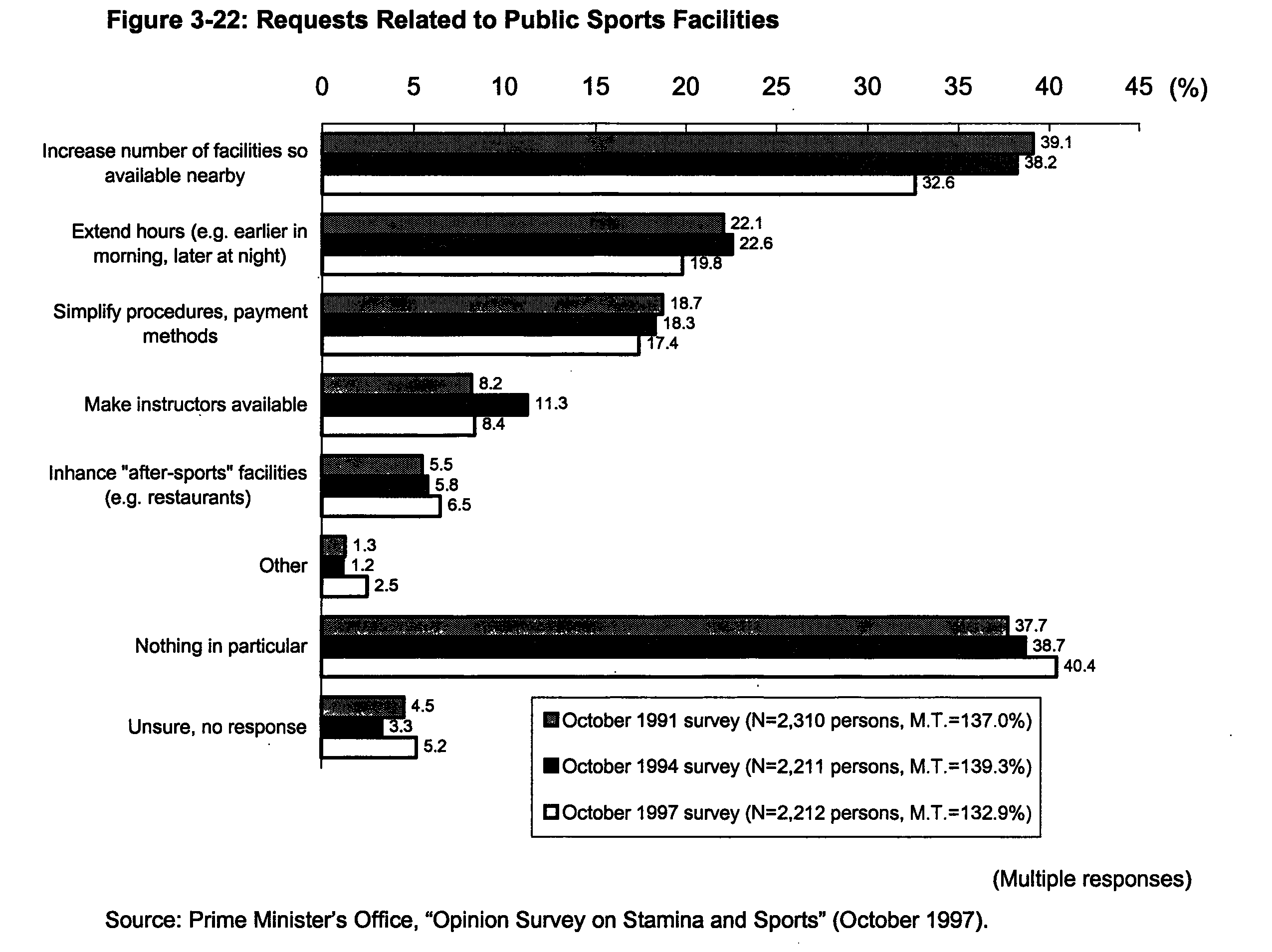
In addition to public sports facilities,it is also necessary to make effective use of school pbysical education facilities,which account for60%of all sports facilities.98%of schools open their physical education facilities to their regional communities in some form or another,although not necessarily in a way that is matched to the local residents'needs.It is necessary to examine the further promotion of and ideal opening of those facilities.
It is important to further increase the number of public sports facilities,but it is also necessary to think about improving the quality.Sports needs at present have become more advanced,making it necessary to develop an environment where people can more comfortably engage in sports.One way to do this is by establishing clubhouses.Clubhouses are also essential in developing comprehensive community sports clubs.Club members can deepen relations with each other by meeting in clubhouses,and they are places for exchange among the residents of a'Inaddition to developing sports facilities,it is therefore necessary to also promote the development of clubhouses.
School physical education facilities are the most familiar spotts facilities and are expected to serve ascommunity sports bases.It is therefore importantthat positive steps be taken to make them available to local residents.Schools are opening uptheir physical education facilities one after theother to their local residents.More than80%ofoutdoor athletic fields and gymnasiums areopen to local residents in one form or anotherbut only about30%of swimming pools and20%of outdoor tennis courts are( see Table3-7 ).As for how the facilities are opened,boardsof education play a central role in58%of thecases,schools in27%and local residents in9%.While school physical education facilitiesare being opened,there are few cases where theyare used for periodical programs.Moreover,tbeprocedures for using them are complex andinformation on their availability does notadequately reach the local residents.In thissense,the needs of the local residents are notadequately being met.Therefore,it is important to switch from the"open-door"approach(i.e.,merely making school physical educationfacilities available to local residents)to a"joint use"approach(i.e.,making those facilitiesa shared asset).In FY1998,MESSC startedcommunity sports exchange projects to promote"joint use"approach in school physicaleducation facilities.
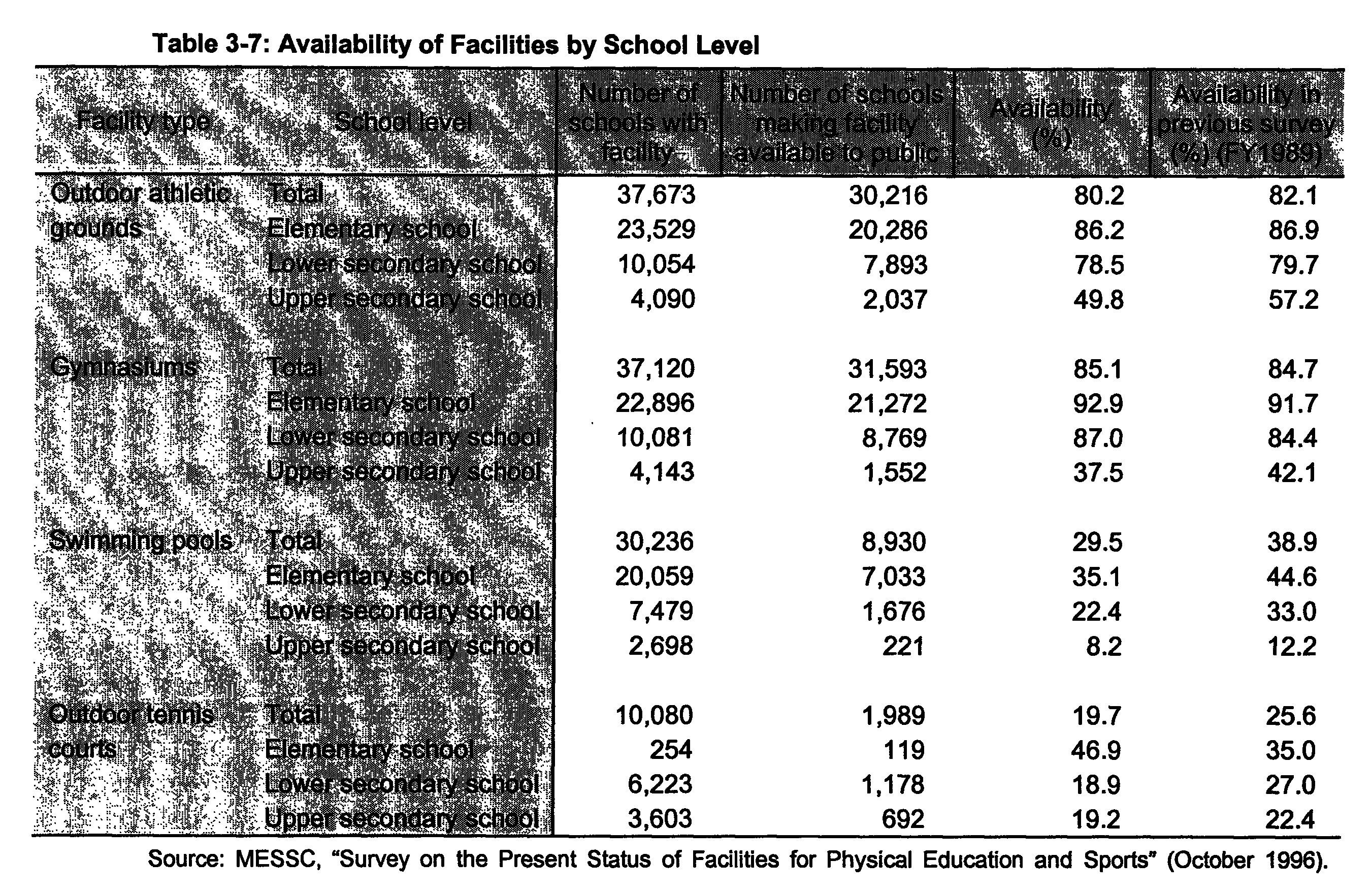
The problem of information on available hours,etc.,not adequately reaching local residents occurs in the case of some public sports facilities as well.It is necessary to publicize such information,to simplify reservation procedures by the introduction of computerized reservation systems and to offer other services for the convenience of users.One way of ensuring that public facilities meet the needs of the local residents is to have them participate in the management and operation of the facilities.In Germany,for example,comprehensive community sports clubs are offered preferential use of public facilities in excbange for managing and operating them.Putting local residents'associations in charge of managing and operating sports facilities also belps reduce operating costs,making such an approacb financially significant as well.
| Back to Top | MEXT HOME |